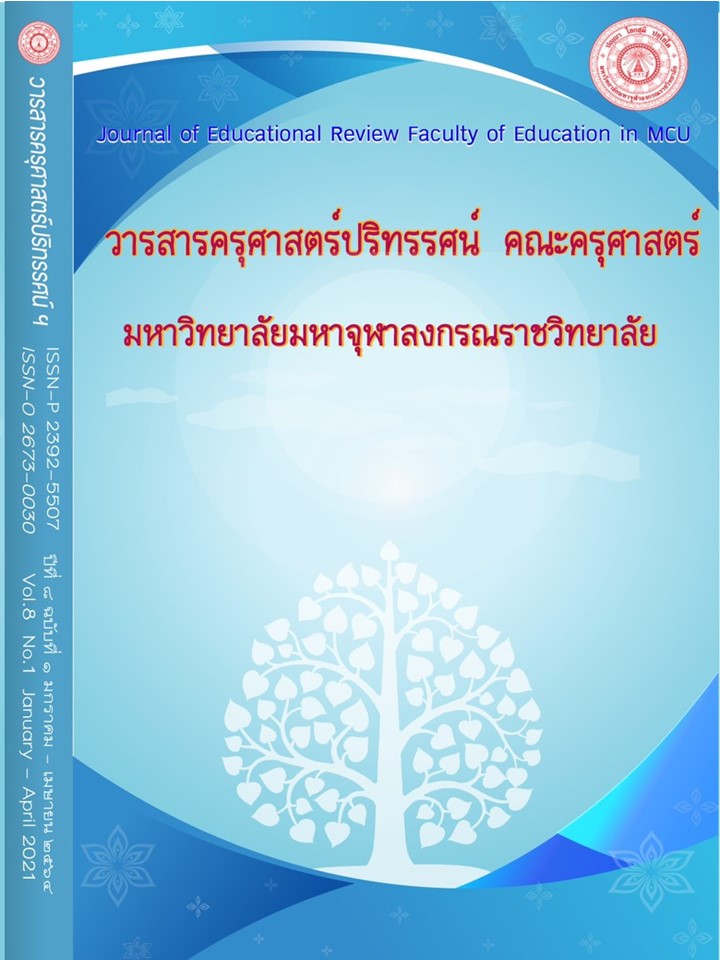A MEDITATION TEACHING MODEL TO SECONDARY SCHOOL STUDENTS IN ACCORDANCE WITH THE MEDITATION STYLE OF PHRABHOMMAMONGKHOLAYAN (WIRIYANG SIRINDHARO)
Main Article Content
Abstract
The purpose of this research was to propose a meditation teaching model to secondary school students in accordance with the meditation style of Phrabhommamongkholayan (Wiriyang Sirindharo). Mixed methods research with 3 steps was designed consisted of Step 1: Study the teaching condition of secondary school students by using questionnaires with 327 students. Data were analyzed by statistical data which were frequency, percentage, mean, standard deviation. Step 2: model developed by interviewing 10 key informants, and step 3 propose a meditation teaching model to secondary school students in accordance with the meditation style of Phrabhommamongkholayan (Wiriyang Sirindharo) by focus group discussion of 10 experts. Research results showed that a meditation teaching model to secondary school students in accordance with the meditation style of Phrabhommamongkholayan (Wiriyang Sirindharo) consisted of 4 parts. Part 1 Introduction which were 1) environment, environment within the school, Environment outside the school, and the difference between the factors of the administrators and the teachers, 2) the basic conceptual principles for teaching and learning are the environment preparation, prepare the body, sitting posture, breathing exercises, and learn to observe breathing. 3) Objectives, benefits, and main goals of attending the Yuwasa meditation course. Part 2, model which were 1) system of work, composition of teaching a meditation course 7 aspects consisted of teachers (meditation teachers), learners, curriculum, teaching materials, teaching objectives, teaching methods, measurement and Evaluation, 2) Management Process, the lecture and practice of the Yuwasa meditation were the purpose of meditation, the 4 points of meditation consisted of the beginning of the meditation, the anti-meditation characteristics, meditation with learning, Witisa meditation, benefits of meditation, concentration on emotional control.Part 3 steps to apply which were 1) structure of the school administration and school administration, 2) decision making, 3) assessment guidelines, and part 4) Conditions for success. It depends on the area, community system and religion.
Article Details
ทัศนะและความคิดเห็นที่ปรากฏในบทความในวารสารฉบับนี้ถือเป็นความรับผิดชอบของผู้เขียนบทความนั้นเพียงผู้เดียว และไม่ถือเป็นทัศนะและความรับผิดชอบของกองบรรณาธิการ
กองบรรณาธิการขอสงวนสิทธิ์ในการคัดเลือกบทความลงตีพิมพ์และจะแจ้งให้เจ้าของบทความทราบหลังจากผู้ประเมินบทความตรวจอ่านบทความแล้ว
ต้นฉบับที่ได้รับการตีพิมพ์ในวารสารครุศาสตร์ปริทรรศน์ คณะครุศาสตร์ มหาวิทยาลัยมหาจุฬาลงกรณราชวิทยาลัย ถือเป็นกรรมสิทธิ์ของคณะครุศาสตร์ มหาวิทยาลัยมหาจุฬาลงกรณราชวิทยาลัย ห้ามนำข้อความทั้งหมดหรือบางส่วนไปพิมพ์ซ้ำ เว้นเสียแต่ว่าจะได้รับอนุญาตจากมหาวิทยาลัยฯ เป็นลายลักษณ์อักษร
References
กระทรวงศึกษาธิการ. (2543). วัดพัฒนา 43. กรงเทพมหานคร: โรงพิมพ์การศาสนา.
ธวัช เติมญวน. (2548). การพัฒนารูปแบบการจัดการเรียนการสอนที่มีประสิทธิภาพในการจัดการศึกษาระดับปริญญาตรีของสถาบันอุดมศึกษาสังกัดกรมศิลปากร. ดุษฎีนิพนธ์การศึกษาดุษฎีบัณฑิต. มหาวิยาลัยศรีนครินทรวิโรฒ.
ปิยะพงษ์ ไสยโสภณ. (2550). การพัฒนารูปแบบการจัดการเรียนรู้แบบมีส่วนร่วม หมวดวิชาพัฒนาทักษะชีวิต 1 ตามหลักสูตรการศึกษาขั้นพื้นฐาน พุทธศักราช 2544 เพื่อเสริมสร้างทักษะชีวิต สำหรับนักศึกษาการศึกษานอกโรงเรียนในทัณฑสถานวัยหนุ่มกลาง. ดุษฎีนิพนธ์การศึกษาดุษฎีบัณฑิต. มหาวิทยาลัยศรีนครินทรวิโรฒ.
พระธรรมธีรราชมหามุนี (โชดก ญาณสิทฺธิ). (2546). วิปัสสนาญาณโสภณ. พิมพ์ครั้งที่ 3. กรุงเทพมหานคร: ศรีอนันต์การพิมพ์.
มหาวิทยาลัยจุฬาลงกรณราชวิทยาลัย. (2539). พระไตรปิฎกฉบับภาษาไทย ฉบับจุฬาลงกรณราชวิทยาลัย. กรุงเทพมหานคร: โรงพิมพ์มหาจุฬาลงกรณราชวิทยาลัย.
มาณี ไชยธีรานุวัฒศิริ และคณะ. (2541). บทบาทพระสงฆ์ในยุคโลกาภิวัตน์: กรณีศึกษาในภาคเหนือและภาคใต้. รายงานการวิจัย. คณะสังคมศาสตร์และมนุษยศาสตร์ มหาวิทยาลัยมหิดล.
ลานธรรมจักร. (2550). ประวัติและปฏิปทา พระพรหมมงคลญาณ (หลวงพ่อวิริยังค์ สิรินธโร). แหล่งที่มา http://www.dhammajak.net/board/viewtopic.php?t=13075 สืบค้นเมื่อ 2 ส.ค. 2561.
วรินทร์ทิพย์ หมี้แสน. (2543). ผลของการฝึกสมาธิตามแนวสติปัฎฐาน 4 ที่มีต่อเชาวน์อารมณ์ของนักเรียน มัธยมศึกษาปีที่ 5 โรงเรียนศึกษาสงเคราะห์ตาก. วิทยานิพนธ์ครุศาสตรมหาบัณฑิต. จุฬาลงกรณ์มหาวิทยาลัย.
สาคร อัฒจักร. (2545). การพัฒนารูปแบบการเรียนการสอนวิชาพระพุทธศาสนาแบบปฏิบัติการอย่างมีส่วนร่วมในโรงเรียนพระปริยัติธรรม. ดุษฎีนิพนธ์การศึกษาดุษฎีบัณฑิต. มหาวิทยาลัยศรีนครินทรวิโรฒ.
สำนักงานคณะกรรมการการศึกษาแห่งชาติ. (2544). บทบาทที่พึงประสงค์ของวัดและพระสงฆ์กับการพัฒนาสังคมไทย. กรุงเทพมหานคร: โรงพิมพ์แห่งจุฬาลงกรณ์มหาวิทยาลัย.
สุทธิลักษณ์ สุทธิ. (2559). สมาธิกับการเสริมสร้างพลังจิตตานุภาพ: วิเคราะห์จากวิธีการสอนสมาธิของพระธรรมมงคลญาณ (หลวงพ่อวิริยังค์ สิรินฺธโร). ดุษฎีนิพนธ์พุทธศาสตรดุษฎีบัณฑิต. มหาวิทยาลัยมหาจุฬาลงกรณราชวิทยาลัย.


